
‘See the bayonets gleam, hark the roll of the drum; As the khaki-clad columns in close order come; Ah, the North may be proud of her record today, When the Ulster Division is up and away.’
March of the Ulster Division (Tune- ‘Bonnie Dundee’)
Little needs said regarding the origins of the Ulster Division of ‘Kitchener’s New Army’. Its intrinsic connection with the Ulster Volunteer Force, and it’s initial almost complete composition of those from a Protestant communal background and a Unionist political disposition, is undisputed. The nature of that formation would become a central element as to how the Division both acted and was received in the public sphere. The Review of the Division is one such instance.
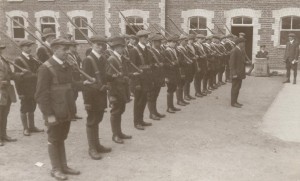
On the 28th October 1914 the official authorisation to form the 36th Ulster Division was given. A recruiting office at number 60 Victoria Street Belfast was opened, and in a relatively short space of time three Brigades where in training at bases in Finner County Donegal; Ballykinlar; South County Down; and at Clandeboye in North Down. They were to move in June to their next scheduled base in Sussex, and it was that anticipated move that was the inception of the events of May 8th 1915.
The first inkling that a mass review of the Division was going to take place came in late April, when the Belfast Newsletter announced that their Head-quarters staff was contemplating what was described as a ‘Great Belfast Project’. Its purpose was stated to be both an opportunity to help general recruitment and a general mobilisation exercise, while also an opportunity for the people of Ulster to see their own Division in ‘something like its full strength’. By the 28th of April it was confirmed that a mass review of the 36th Ulster Division would take place including inspections of the force, a march past the City Hall; and composing of around 17,000 troops.

Newspapers across the Province almost instantaneously were publishing advertisements for the event, which appeared beside the timetables for specially chartered excursion trains drawing people from every Ulster County to the proceedings. The Secretary of State for War, Field-Marshall Kitchener was reported as being invited to review the troops, however just a few days prior signalled his inability to attend. The role of inspecting officer instead fell to Major-General Sir Hugh Mc Calmont, Colonel of the 7th Hussars and for a brief time M.P. for North Antrim.

The sheer scale of the Review meant that substantial traffic control arrangements had to be put in place and enforced in the City to ensure the parade moved freely. From 1.30pm until the parade passed no vehicular traffic was permitted inside the defined city boundaries of the Lisburn Road, Bradbury Place, Great Victoria Street and Wellington Place. Further notice was given that tram services were likely to be irregular during the day, and that all inward travelling trams would be going to Castle junction ‘or as near thereto as is safe and convenient’. Those spectating such as people having seats in windows etc., were told they MUST be in position by 1.30pm. The idea of windows being used as vantage points was not an uncommon one, with one City Centre firm alone inundated with 800 requests to use its particular windows!
For the troops it was ordered that all bar those receiving their own specified allowance should carry one day’s field rations, including 1lb preserved meat and 1lb of biscuit. The many different route marches required on the day were also to be used as further opportunity to instruct in the men in field cooking.

When Saturday 8th May came, the entirety of the 36th Ulster Division was in Belfast with the exception of the 10th Inniskilling Fusiliers (The Derry’s) and those detachments that had been left to guard the camps. In what every Irish newspaper, irrespective of whether Unionist or Nationalist in orientation, described as glorious weather; the participants had been arriving in the City as early as Thursday, but the majority did not arrive until Saturday morning. The parade began with an inspection and march-past at Grounds at Malone in South Belfast. Limited space meant this element was closed to the public, however many lined a high portion of Malone Golf links where they could view the events. After the inspection by Mc Calmont, the troops began to file from the fields and as they reached the road form into column and began to make their way to the City Centre.
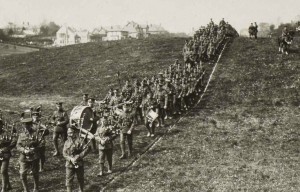
Massive crowds lined the route, with those awaiting the arrival of the procession the most excitable in Donegal Place where the military marshal’s had to work hard to stop them swarming into Donegal Square. After the lines were broken through a few times, a fire engine was brought to the location and parked broadside, however this only resulted in climbing on to the machine for a vantage point. Eventually the crowd had to be forced back by mounted men and heavy ropes suspended between electric poles to keep the crowd in check. A Mr Irwin reminisced that as a boy he had ‘never seen anything like it before’ and that the roads were lined with people waving and shouting.
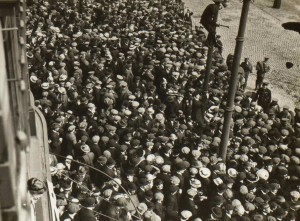
A saluting base was constructed at the City Hall, with a stand also erected nearby inside the grounds to accommodate 400 invited guests, including Sir Edward Carson, Lady Carson, the Mayor of Belfast and the Commander of the Ulster Volunteer Force Sir George Richardson. Businesses in the vicinity were closed for the duration of the parade and the streets decorated with flags, bunting and even makeshift arches. R. H. Stewart of Waringstown wrote that the parade was like a ‘twelfth of July and Covenant Day all rolled into one’.
At 2.45pm the then Divisional Commander of the 36th, Major General Powell, arrived at the saluting base at the head of the parade; with a steady stream of the division following for at least a further hour and forty minutes. Each unit of soldiers was greeted with tremendous waves of applause and hurrahs. The papers reported on a body of men of good physique and impressive appearance and military bearing, with even the Nationalist Irish News and Freemans Journal remarking on the denseness of the crowds and noting the number of participants as circa 17,000.
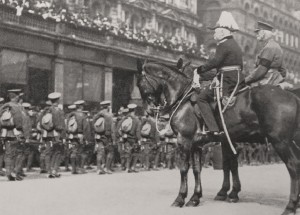
Some of the words of a Belfast Newsletter editorial of May 1915 read…
‘The 8th of May 1915 must rank in importance with that Saturday in September two and a half years ago [Ulster Day], when the Protestant people of Ulster pledged themselves to defend their religious freedom and take up arms against the cause of Home Rule… The gallant young soldiers who so proudly marched from Malone after an inspection… are on their way to fight another enemy… We wish them God’s help in maintaining Ulster’s Place in the British Empire.’
The sole mass mobilisation of the 36th Ulster Division on their home soil in Ireland wasn’t seen as just men being given a farewell as they journeyed to war. The Review of the 36th Ulster Division meant much more to the Unionist people of Ulster. It was another step in their fight to stop the imposition of Home-Rule and perhaps even to simply maintain their identity. A fight that would take on even greater symbolism and meaning just 14 months later, when the men of the 36th would meet a barrage of fire on the battlefields of the Somme.
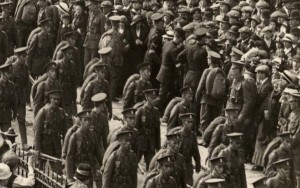

Leave a Reply